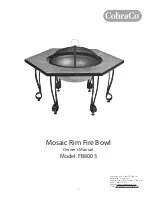
© 2012, Pinnacle Products International, Inc.
4
Convection Heater User’s Manual
Specifications
Figure 1:
Product Specifications
PROPANE
You must provide the propane gas and cylinder(s). Use this
heater only with a propane vapor withdrawal supply system.
Refer to Chapter 5 of the Standard for Storage and Handling of
Liquefied Petroleum Gas , ANSI/NFPA 58. Your local library or
fire department will have this booklet.
LP Characteristics:
- Flammable, explosive under pressure, heavier than air, and
pools in low areas.
- In its natural state, propane has no odor, but for your safety an
odorant that smells like rotten cabbage has been added.
- Contact of propane (LP) gas with the skin can cause freeze
burns.
- Heater is manufactured for use with LP gas only. DO NOT
attempt to convert to any other gas. Such modifications are
dangerous, and will void warranty.
- When heater is not in use, LP cylinder must be turned OFF
- Be sure that the LP cylinder is located on a level and stable
surface.
- Do not use this heater in a basement or below ground level.
Propane (LP) is heavier than air, and will always seek the
lowest level. If you suspect a leak, shut off the valve at the LP
cylinder immediately.
The Propane (LP) cylinder must also be equipped with the
following:
- A collar to protect the gas valve.
- A shut-off valve terminating a LP cylinder valve outlet as
specified in the American National Standard for Compressed
Gas Cylinder Valve Outlets and Inlet Connections.
- A safety relief valve having direct communications with the
vapor space of the LP cylinder.
- An arrangement of vapor withdrawal.
The amount of LPG used with this heater varies. Both factors
are:
1. The amount of gas in the cylinder of LPG.
2. The temperature of the LP tank and its surroundings.
Propane is safe to use when properly
handled. Careless handling of the LP
cylinder could result in a fire and/or an explosion. Therefore:
- Always keep LP cylinder securely fastened and in an upright
position.
- Avoid tipping the LP cylinder on its side when connected to a
regulator, since this may cause damage to the dia phragm in the
regulator.
- Handle valves with care.
- Never connect an unregulated LP cylinder to a construction
heater.
- Do not subject LP cylinder to excessive heat.
- Tightly close the gas shutoff valve on the LP cylinder after each
use.
- All fittings must be protected when disconnected from the LP
cylinder.
- Never store an LP cylinder inside a building or in the vicinity of
any gas burning appliance.
The disconnected tank must never be
stored in a building, garage or any other
enclosed area.
- Do not restrict inlet or outlet of heater. Heater is never to be
used with ductwork.
Propane Supply / Information
Figure 2:
The table above shows the minimum number of
100 lb LP cylinders required in cold weather. Your local LP
dealer will help you select the proper LP supply system.
Average
Temp (°F)
MH-80V-LPC
100 lb. cylinders
MH-200V-LPC
100 lb. cylinders
32°
1
2
20°
1
2
10°
2
3
0°
2
3
-10°
2
3
-20°
2
3
CAUTION
CAUTION
Model #
Rating BTU/Hr
Fuel Consumption
Supply Pressure Manifold Pressure
Spark
Gap
High
Low
Gal/Hr.
Min/Max
Lbs/Hr
Min/Max
Max
Min
High
Low
MH-80V-LPC
80,000
60,000
.66/.87
2.8/3.7
200 psi
20 psi
8.5” wc
10.5” wc
.195”
MH-200V-LPC
200,000
70,000
.76/2.19
3.2/9.3
200 psi
20 psi
4.0 psi
5.0 psi
.195”
Fuel Type:
Liquid Propane Only
Ignition Type:
Piezo
Minimum Operating Air Temperature:
..-20F(-29C)
NEVER LEAVE HEATER UNATTEND-
ED WHILE BURNING, OR WHILE
CONNECTED TO A FUEL SOURCE


























